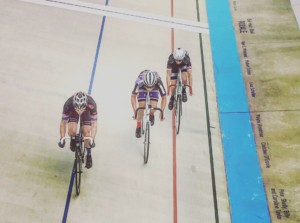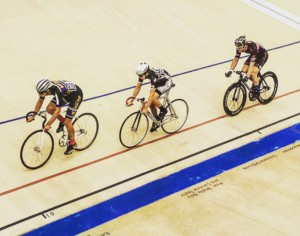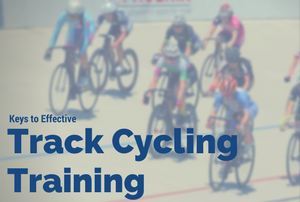Track cycling is one of the toughest, most physically demanding disciplines in cycling. These cyclists are the kings of power, finesse, and cunning. Not only do they have to account for their own positioning and tactics, they have to account for the tactics of the track they're riding on. Track cycling training is also quite unlike almost any other cycling training. Compared to road racers who spend hours on end putting in miles on the road, track training is heavily dependent on strength work and short interval work.
This can be difficult for a lot of cyclists to come to grips with because it's much more dependent on high-intensity work than other cycling disciplines.
So, if racing on the track or being a stronger sprinter is on your checklist, click through the jump.
Strength Training for Track Cycling
The base of a strong track cycling training program undoubtedly revolves around strength training. I've covered this in depth in my previous articles on Strength Training for Cyclists Part 1 and Part 2.
One of the keys to a strong track or sprint performance is the ability to push the pedals hard. Since track bikes are fixed gear bikes (meaning the rear wheel and crankset are tied together and move as one) each race start is generally a standing start. This involves putting huge forces into the pedals in order to get the bike moving. It's also a key to working yourself into a strong position as the race kicks off.
In the gym, closed chain posterior chain exercises are the bread and butter of a training program. Loaded squats, deadlifts, lunges and plyometric exercises are hugely beneficial to developing leg strength. Core strength and stability are also important aspects of track cycling, so check out my post on core strength and stability for more details. Compared to a road racing cyclist who may perform strength training during the winter and taper off as the season approaches, track racers tend to continue to lift throughout their season. Lexapro generic
 Strength Training on the Bike
Strength Training on the Bike
Once a significant volume of strength and conditioning has been performed, it's time to take it to the bike. On bike force work intervals are important to build the connection between strength in the gym and strength on the bike. Force intervals typically involve very low cadence and high tension drills. In most cases, you'll be performing intervals of 1-2 minutes under high tension at cadences around 60 RPM. These should make up around 10%-20% of your on-bike training during the early part of a track cycling training season.
It's important to mention core stability here again. I've talked about core stability and strength in the past, so check out that podcast for more detailed information. In short, track cycling, in particular, requires a high degree of core stability and strength to harness the massive power generated during sprint efforts. Rotational stability and upper body stability is necessary otherwise a ton of power can be lost during out of the saddle efforts.
Of course, all the leg strength in the world is of little use if you can't effectively apply it to the pedals. https://imamiddleeast.org/vermox-online/
Neuromuscular Capacity and Cadence Training
Developing power on the bike is a function of how hard you push the pedals and how fast you turn them. So if you want to produce more power, you can either push harder or spin faster. Track cyclists, in particular, are known for being some of the most supple, fast pedaling cyclists on the planet. Check out the video below from a Japanese Keirin school to get an idea of how fast some of these guys can rev up a cadence.
Since a track bike is a fixed gear, the ability to change cadence is one of the most important skills to have. You have one gear to pedal, you have to be able to push that gear from zero to 130RPM or faster. Neuromuscular work such as superspin work, single leg drills, and spin-ups are necessary to build the appropriate neuromuscular adaptations. I've also talked about neuromuscular training in the past, but I'll review it again here.
Your body is designed so that impulses from your brain travel through your nerves to your muscles. Each nerve branches out and interfaces with several bundles of muscle fibers. Your muscles are made of thousands of these bundles of muscle fibers. So, in order for a muscle to contract, those bundles have to fire in unison. In untrained cyclists, there's some small variation in the coordination of these impulses. The more training performed, the more coordinated these impulses become.
As those impulses become more coordinated, more power can be produced during each pedal stroke. The faster the muscles can contract and relax, the faster you can push the pedals around and the more power you can produce. For that reason, building neuromuscular coordination is a key to a good track performance. https://imamiddleeast.org/zoloft-online/
Track Cycling Training on Rollers
Rollers deserve a special mention in any track cycling article Many times you'll see track cyclists warming up on rollers. This is one of the most efficient ways to warm up, but it also has huge benefits for training. Rollers, in contrast to a stationary trainer, offer a lot of core stability integration during your workout. They also replicate road feel (or track feel, if you prefer) much better than a stationary trainer.
Rollers are the perfect platform for working on neuromuscular training. Since your wheels are not tied into a frame and are free to float over the rollers you're forced to be supple, smooth and efficient. Your core stability is also challenged in order to keep your wheels on the rollers. When all said and done, a roller workout will give you bigger benefits than an equivalent workout on a stationary trainer.
Programming Track Cycling Interval Workouts
Because track cycling is a very anaerobic form of racing, most of your interval workouts will be anaerobic in nature. Thankfully, you don't have to live next to a track to perform most of your on bike training. A standard road bike is just fine for most of your training requirements. Zone 5 and VO2 max workouts are important for raising VO2 max and improving your aerobic ceiling. Building zone 6 endurance is one of the keys to stick with hard accelerations out of the corners. Zone 7 training will help you get through the last lap fast and efficiently.
 Track Cycling Base Training
Track Cycling Base Training
When building your training program, in the base phase you'll focus on strength training, neuromuscular conditioning and endurance training. Spend about 30% of your time training in the gym, building core strength and stability. You'll want to progressively increase the intensity through the base phase until you start racing.
40%-50% of your base training should be aerobic conditioning. This aerobic conditioning should consist of a lot of sweetspot training and neuromuscular skills. This is where you'll plug in superspin work, single leg drills and spin ups. You can also build in some force intervals if you keep the intensity down around sweetspot intensity.
The final 10%-20% of your training should be made up of anaerobic conditioning. In this case, stick to short duration VO2 max intervals of around 3-4 minutes duration with plenty of rest. You'll also want to add higher intensity force work in this aspect of your training.
Track Cycling Build Training
During the build phase of your training program, priorities shift a little bit. You'll probably start racing some early season races. Around 20% of your training will still be strength training in the gym. At this point, maintaining core strength and stability gains is critical as you start racing.
40%-50% of your training will be aerobic in nature. Functional Threshold Power intervals around 100% of your threshold make up the bulk of your aerobic training. Continue building neuromuscular conditioning with superspin work. Add in some singlespeed style workouts to simulate the changes in speed during a track event.
The remaining 30%-40% of your training will focus on anaerobic work. During the build phase, you'll start adding track starts (sprints from a standing stop in a big gear) and track sprints (winding up the pedals and sprinting from a constant speed.). These intervals will begin training the necessary energy systems to start a race and finish a race. It is also important to add some repeated Zone 6 efforts to mimic the ability to ride a hard lap. Efforts like 30 second on/30 seconds off for 5 minutes are a good place to start.
Track Cycling Peak Phase Training
During the peak phase, you need to focus on reducing your fatigue and increasing your form. This means you'll cut down on your volume significantly and ramp up the intensity of your remaining training time. Interval workouts should be short (no more than an hour) and intense (around 80-90 TSS in that hour.)
The decreased volume of training allows for massively increased rest in between workouts. By your target race, the increased rest should reduce your fatigue and leave you feeling fresh. The increased intensity of the remaining interval work will maintain your racing edge and keep your body ready to perform.
Track Cycling Resources
For a great selection of track cycling gear, you can shop BLS or The Velodrome Shop.
If you're looking for help with strength training and core stability training, check out my Raw Strength program and Unbreakable Core Stability program.
To build some fitness that will help you handle crit racing or track racing, check out my Advanced Full Season training solution and my Crit module.
